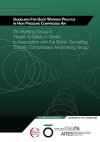Work in compressed air and diving both involve exposure to hyperbaric environments. However when at work in compressed air, immersion is in a gas whereas when at work in diving, immersion is in a liquid. Humans have evolved to breathe gas but require the use of breathing apparatus when underwater. Those working in compressed air lack the buoyancy of divers. These and other factors give rise to a number of significant differences in the human physiological response to pressure exposure depending on whether it is work in compressed air or diving which is being undertaken. The gas/liquid issue also gives rise to different pressure profiles affecting those exposed. It is important that the differences between the two activities are recognised and due account taken of them. However for the period spent living in a surface habitat during saturation exposures, there are no physiological differences between work in compressed air and diving. Whilst there is considerable guidance on mixed gas breathing and saturation exposure techniques in diving, to date there is very little similar guidance specifically aimed at tunnelling.
Report 10 is intended to complement existing national legislation, standards and guidance as appropriate. As HPCA work is still a rarely used but developing technique, few countries are likely to have altered existing legislation and guidance to permit its use.
These Guidelines set out good practice in high pressure compressed air work in the form of recommendations. Although guidance generally has a lower standing than regulation or standards, that standing can be raised to the equivalent of a standard where the guidance forms a normative reference in a standard or is adopted by a regulatory authority as the basis for its enforcement activity. The guidance given in this Report aims to be goal setting in nature rather than prescriptive. However, because of the lack of alternative sources of published information or standards on high pressure compressed air (HPCA) work, some of the recommendations given are fairly detailed.
Users of this guidance are free to adopt their own solutions but these should not be less safe than the recommendations in this document. For limits quoted, such as maximum gas exposure limits, the recommended values or range of values given have been arrived at over a period as the consensus of expert opinion normally within the diving or hyperbaric medical community. As experience of HPCA work increases, it is now becoming possible to modify some limits for tunnelling applications.
Means of achieving set goals have been given in some cases, however other equally valid means of achieving the same goals can exist and it is down to the experience of the reader to select the (more) most appropriate.
Likewise, not all hyperbaric situations have been covered and the reader should use professional discretion and experience in determining the appropriateness of applying or interpolating between recommendations given in the text. As high pressure compressed air work differs in a number of fundamental respects from diving such as transfer under pressure techniques and the consequences of immersion in a gas rather than a liquid are different, rigid adherence to diving practice and guidance can often be inappropriate...
